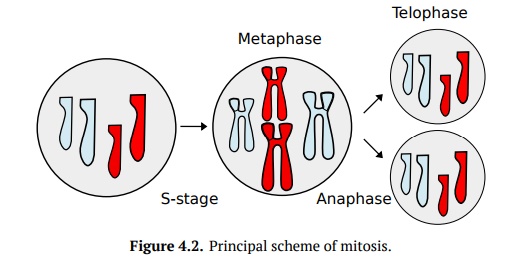Chapter: Introduction to Botany: Multicellularity, the Cell Cycle and the Life Cycle
Mitosis and the Cell Cycle
Mitosis and the Cell Cycle
Mitosis is a process of equal cell division, where each of the new cells
receivesthe same number of chromosomes as the original cell. Mitosis does not
change the cells’ genotype. The goal of mitosis is to distribute pre-combined
genetic material equally. Actually, mitosis is a kind of karyokinesis, or splitting of the nucleus, as opposed to cytokinesis, which is the splitting of
the whole cell. Karyokinesis and cytokinesis are parts of the cell cycle (Fig. 4.3).

All prokaryotes
(Monera) have a simple cell division called “binary fission”. DNA duplicates
(replication), segregates and then cell splits in two (Fig. 4.1).

Eukaryotes have much
more DNA than prokaryotes. This is why their cell divi-sion is more
complicated. There are four stages: prophase, metaphase, anaphase, and
telophase. Prophase is the longest,
nucleus disintegrates (except some pro-tists like fungi) and the DNA is
super-spiralized into chromosomes (“archived”). In metaphase, the chromosomes go to the cell equator, and every
“double”, “X-like” chromosome is then split in two halves which schematically
can be shown as
X -> I + I
In anaphase, microtubules move these I-like chromosomes to different poles of
the cell. In telophase, the
endoplasmic reticulum will form nuclear envelopes and DNA despiralizes (Fig. 4.2).

When mitosis is over,
cell starts to divide (cytokinesis). Plant2 cells use vesicles to form the border whereas
many protists and animals form a constriction which finally separates two
cells. Normally, chloroplasts and mitochodria are equally distributed between
daughter cells along with the other cell content. Chloro-plasts and
mitochondria may also independently divide in “bacterial” (binary fission)
Mitosis is the part of
the bigger cell cycle (Fig. 4.3). Cell cycle includes pre-synthetic stage,
synthetic stage, post-synthetic
stage (they are parts of in-terphase),
karyokinesis (= mitosis) and finally cytokinesis. Apart from mitosisand
cytokinesis, the most important stage of cell cycle is the synthetic stage(S-stage)
when every DNA molecule (despiralized chromosome) duplicates:
I -> X
To simplify
understanding of these numerous stages, one could use the following scheme.
Cell cycle here has three main phases, and mitosis has four subphases:


Related Topics